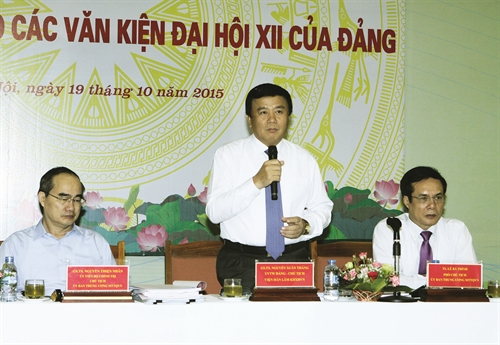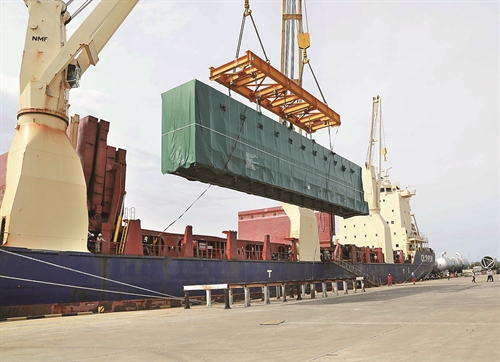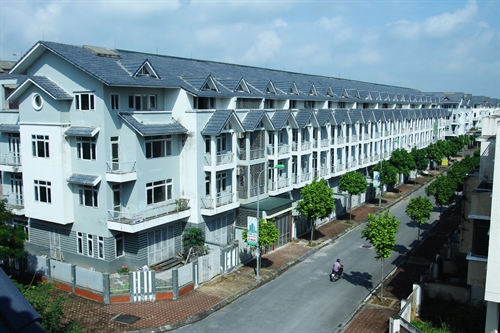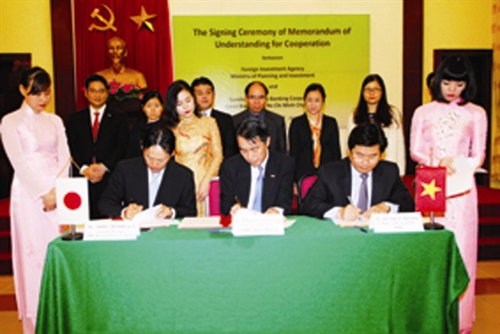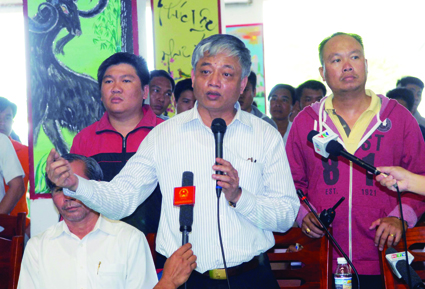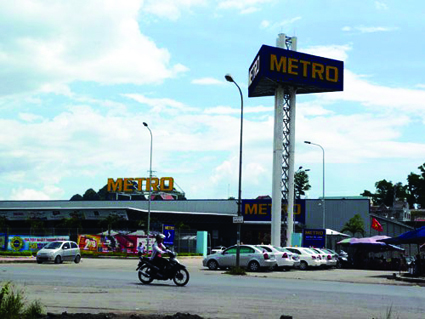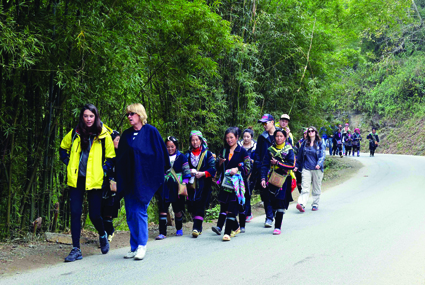The International Labor Organization (ILO) estimated employment in Vietnam will increase 10.5 percent by 2025, with services and industries (mostly garment and construction) accounting for over 41 percent and 23.5 percent of the total employment respectively, as a result of the formation of this economic bloc.
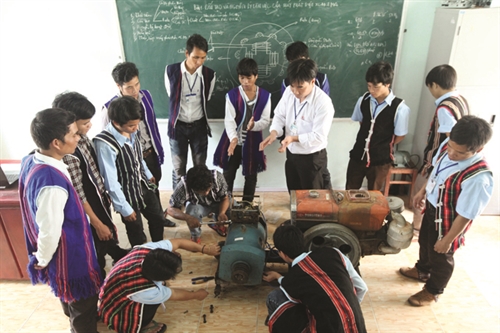 |
| A household electric and electro-mechanic enginerring class in the Intermediate Vocational School for Ethnic Minority and Mountainous Youth of Quang Nam province__Photo: Anh Tuan/VNA |
According to a recent ILO survey, from 2010 to 2025, the demand for medium-skilled labor within the region is estimated to rise 27.9 percent and that for low-skilled labor, 22.6 percent while the demand for high-skilled labor will grow at just 13.2 With a working-age population of nearly 53 million, a high literacy rate of over 93 percent and encouraging achievements in basic education, Vietnam is ready to meet the need for low-skilled labor in the near future.
The quality of Vietnamese labor has also been increased with the rate of trained labor rising from 30 percent to 50 percent over the last ten years, partially meeting the requirements of the labor market. The qualification of Vietnamese technical labor has been improved as expressed in the increasing number of local technicians capable of doing complex jobs which used to be taken merely by foreigners.
The country has also been sending workers to ASEAN countries, with thousands annually to Malaysia alone, reflecting its workers’ capability to integrate into the regional community together with the flow of trade, services, investment and capital.
Nevertheless, the quality of Vietnamese human resources remained low and lagged far behind the region. The quality of Vietnamese labor was rated by the World Bank at merely 3.39 points on the 10-point scale, ranking 11th among 12 rated Asian countries, much lower than South Korea with 6.91 points, India, 5.76 points and Malaysia, 5.59 points.
The country’s productivity was low, just one-fifteenth of Singapore, one-fifth of Malaysia and two-fifths of Thailand, being grouped in the four bottom ASEAN countries for its low capital, scientific and technological and labor levels.
Technical labor made up less than half of the total labor force while the country’s human development index was relative low, standing at 0.638 as compared with 0.901 of Singapore, and was not much higher than Cambodia, Laos and Myanmar.
Not only short of skilled labor, even trained workers failed to meet requirements on job-related skills and have to be retrained in many cases, analysts pointed out, adding poor English proficiency, lack of cognitive skills (such as problem solving and critical thinking) and core skills (teamwork and communication) as well as lack of work discipline were other disadvantages for Vietnamese workers to compete with those from Singapore, Indonesia, Thailand and Malaysia.
Analysts attributed the problem to the fact that despite the country’s recent economic growth, nearly half of the labor force was working in the agricultural sector where productivity, incomes and working conditions remained typically low as compared with the regional level. Around 45 percent of the agricultural labor was not trained.
According to the General Statistics Office’s 2012 statistics, labor trained at the vocational level made up nearly 5 percent of the total workforce, at the professional secondary level, 3.6 percent and at the collegial and higher levels, over 8 percent.
Dr. Mac Van Tien, director of the National Institute for Vocational Training, attributed the poor quality of human resources to inappropriate and low-quality training which failed to meet the country’s requirements for industrialization, modernization and international integration.
He also blamed on limited information about the labor market which failed to meet the demand of stakeholders, particularly employers and employees. The country also lacked a reliable and consistent mechanism for labor market forecast as a result of lack of personnel in statistical, analysis and forecast work.
Addressing a seminar in Hanoi this month to discuss on the labor market after the establishment of AEC, Deputy Minister of Labor, War Invalids and Social Affairs Doan Mau Diep expressed his concern over the still low skills of Vietnamese labor, saying Vietnamese may lose jobs right at home, given the immediate free movement of labor within the region in eight occupations, namely accountants, architects, medical and dental practitioners, engineers, nurses, surveyors and tourism professionals, which required high professional qualifications.
Dr. Nguyen Thi Lan Huong, director of the Institute of Labor Science and Social Affairs, agreed Vietnam might lose in the competition with its neighbors on the skilled labor market, given Vietnamese labor was rated just higher than Laos, Myanmar and Cambodia. She stressed the State should promptly adopt policies to support training of qualified labor up to international standards while businesses should also increase training and retraining for their employees to meet their own employment requirements.
Talentnet Executive Director Tieu Yen Trinh said Vietnam should build the national trademark for its human resources to compete with regional rivals.
The country should build up technical barriers on work conditions and permits to protect local workers and ensure reasonable movement of labor, according to Ha Thi Minh Duc, Deputy Director of the International Cooperation Department of the Ministry of Labor, War Invalids and Social Affairs.
Comprehensively renewing occupational training was key to raising the quality and competitiveness of Vietnamese human resources, said Dr. Tien, stressing occupational training must be prioritized in every socio-economic development program or project of each locality, region or industry.
He suggested the improvement of mechanisms and policies on vocational training and revision of the Law on Vocational Training and relevant laws toward introducing incentives for vocational trainers, heads of vocational training institutions and vocationally trained labor, as well as mechanisms allowing employers to join the making, evaluation and adjustment of training programs and training and evaluation of performance of learners.
He pointed to the need to renew training activities by focusing on developing learners’ occupational skills and capacity rather than merely on theoretical knowledge to form their professional behavior, capability, skills and knowledge.
In addition, training must be associated with the labor market demand by involving employers to provide information on their employment needs and feedback on qualifications of employees.
The country should also increase international cooperation in vocational training and call for ODA for vocational training, Tien said.
Tong Hai Nam, deputy director of the Department of Overseas Labor of the Ministry of Labor, War Invalids and Social Affairs stressed state management agencies should adopt solutions to help Vietnamese workers acquire professional skills and knowledge, including understanding about the culture and working environments of their working destinations.
AEC was established on December 31, 2015, to transform ASEAN into a region with free movement of goods, services, investment and skilled labor and free flow of capital.
The bloc consists of ten member states, namely Brunei, Cambodia, Indonesia, Laos, Malaysia, Myanmar, the Philippines, Singapore, Thailand and Vietnam, with a total population of over 615 million, including over 315 million in the labor force. Indonesia, Vietnam and the Philippines make up the largest labor of the bloc, accounting for a total 70 percent of the community’s workforce.- (VLLF)

